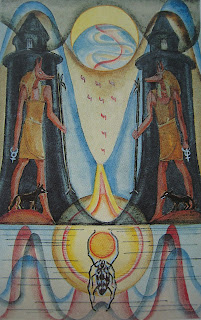In the astrological correspondence system that I follow, Pisces
is linked to the Eight, Nine and Ten of Cups. Today I’m going to look at the
Eight of Cups, which corresponds to Saturn in Pisces – and to the first third
of Pisces (so this year, the 18th-27th February).
Pisces is the mutable Water sign, so we’re looking at our
emotional resources and how these might need to change. Saturn sets limits – something that Pisces
doesn’t like! – but also helps us to maintain our integrity. Combined with
Pisces, it wants to transcend the restrictions that we find ourselves
surrounded by so that we can ‘merge’ with others. It needs to find a way to express its feelings
in such a way that it still feels stable – but not stuck.
 |
Eight of Cups (trimmed):
© Sharman-Burke/Caselli Tarot
|
So how might this play out in the Eight of Cups? Let’s start with a relatively ‘traditional’
depiction of the Eight of Cups – as illustrated by the Sharman-Burke/Caselli (Beginners Guide to the Tarot) deck.
Here we see a figure walking away from eight cups, neatly and carefully
stacked. Despite the care taken to place
the cups in this pattern, the figure is abandoning them because they no longer
provide the emotional security needed.
Notice the waning moon in the sky – something is drawing to an end. There’s no sign of any life in the landscape,
so there’s no hint as to what the figure is heading towards. But ‘8’ is the
number of death and birth (8th house themes, in astrology), cycles
and recycling – time to let go of what’s no longer working, time to move
forward to something new and (as yet) unknown (shades of the Moon card,
associated with Pisces). Otherwise, stagnation looms.
 |
Eight of Cups (trimmed):
© Thoth Tarot
|
Stagnation is the theme of the Eight of Cups in the Thoth
deck, showing us the other side of the coin, so to speak. Here we see standing water, unmoving, at risk
of becoming stagnant without the flow of fresh water to refresh the
situation. Saturn represents the needs
to set some new limits, to learn to say ‘no’, to walk away from a situation or
relationship – something that’s close to the heart - that’s no longer working,
despite all the time and effort that’s been put into it. Things have run their
course, the well is dry; it’s time to move on. Saturn in Pisces speaks of the
need to change old patterns so that we don’t become stuck in an emotional rut,
or stagnate.
 |
Eight of Vessels (trimmed):
© Wildwood Tarot
|
The Wildwood Tarot wasn't created with astrology in mind, but I like to look at it to see if there's any connections in the imagery. In the Eight of Vessels we see water flowing freely -
but is it? The rocks place boundaries on the water, collecting it in pools
before channelling it between rocks to keep it moving! So yes, Saturn in Pisces works here...
 |
Eight of Cups (trimmed):
© Margarete Petersen Tarot
|
In Margarete Petersen’s Eight of Cups, the frame around the
image alone gives us a sense of structure being imposed, something being restricted.
Within the frame, an upside-down head is
submerged in the deep blue sea. A stream of lighter blue emanates from it up to
the surface – air rising to the surface and on up into the atmosphere (as I see
it!). Again, the idea of being trapped in the depths of something that feels
out of our control, yet we find a way to breathe and draw in air from beyond
the barrier that holds us in this ‘hemmed-in’ state/place. And if we don’t?
Indolence, or a sense of stagnation, could set in.
Beginner’s Guide to
the Tarot created by Juliet Sharman-Burke, illustrated
by Giovanni Caselli, published by Connections
Margarete Petersen Tarot,
AGM-URANIA/Deep Books, 2004.
Thoth Tarot created by Aleister Crowley, illustrated by
Lady Frieda Harris, published by U.S. Games Systems, Inc.
Wildwood Tarot created by Mark
Ryan and John Matthews, illustrated by Will Worthington, published by
Connections

















